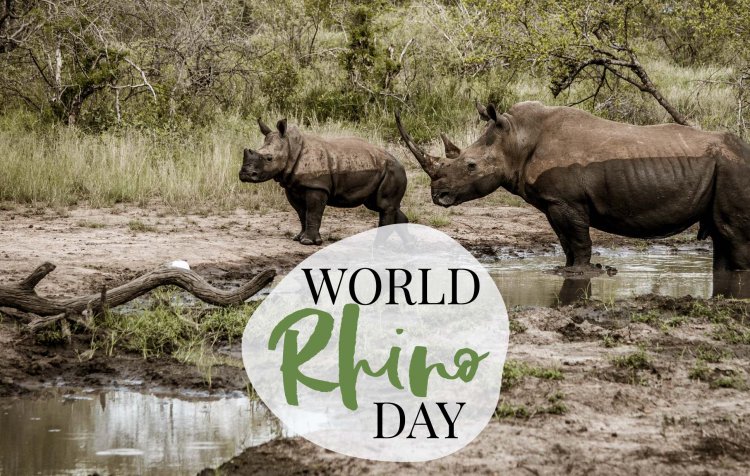World Rhino Day 2019: Amazing Facts about Rhinoceros You Might Not Know

Every year, World Rhino Day is celebrated on September 22. It is a special day that gives cause-related organizations, NGOs, zoos, and people a platform to celebrate endangered parts of the species in their unique ways.
The initiative was announced by the WWF-South Africa in 2010, and since then various species of rhinos have been celebrated across the world.
Here are some quick amazing facts about the gigantic species that you must know.
- The word Rhinoceros is a combination of two Greek words, ‘rhino’ meaning nose and ‘ceros’ meaning horn. Rhinos have around 24 to 34 teeth, depending on the species.
- Rhinos are one of the oldest animals to be found. Their legacy is carried on for more than 50 million years. Some of the world’s initial species didn’t have horns and were specifically found in North America and Europe. However, none of the known rhino species have ever inhabited the South American or Australian continents. Sumatran rhino is the nearest living relative of the ancient woolly rhino.
- While one may be famous than the other, there are five different species of rhinos that are found around. The species include white and black (found in Africa), Indian, Javan, and Sumatran (found in southern Asia).
- Although called as Rhino (nose horn), its horn is not a bone and isn’t even attached to the skull. It is in fact, hollow and made from a protein called Keratin. Human fingernails and hair are made of Keratin, and just like our growth, a rhino’s horn grows throughout the animal’s lifetime. According to Save the Rhino, a conservation charity based in the UK, the longest known horn was 4 feet 9 inches long on a black rhino. Rhino horn has no medical properties, but it is still used in traditional Asian medication.
- Rhinos represent the group of herbivorous mammals named Perissodactyla, who possess either one or three hoofed toes on each hindfoot. This group contains only three extant animal families namely, Rhinocerotidae (rhinos), Equidae (horses, zebras, and asses) and Tapiridae (tapirs).
- When it comes to hearing and smelling abilities, none can beat a Rhino. However, they have poor eyesight and find it difficult to spot anything only a hundred feet away.
- Rhinos can run up to 40 miles per hour.
- Rhinos are known for their thick skin, but not many know that it can be very sensitive to sunburns and insect bites. To protect their skin from dryness, sun, and bites, rhinos wallow in the mud. Rhinos also love to rub their bodies against tree trunks and rocks to remove ectoparasites.
- The Javan rhino is named the world’s rarest land mammal. They are found in Indonesia’s Ujong Kulon National Park, as per Save the Rhino, only 50 survive.
- Mother Rhinos are very nurturing and caring. Their gestation period lasts for 15 to 16 months. Young rhinos stay with their mothers only until they turn 3 years old.
- Rhinos height ranges from 6 feet to more than 11 feet, depending on the species. After the elephant, the white rhino is the second-largest land mammal. The adult male white rhinos weigh up to a massive 3.6 tons.
- Rhinos mark their territories with dung heaps called middens. Males, as well as females, use these home ranges to communicate their whereabouts and reproductive condition.
- Rhinos have a symbiotic relationship with oxpeckers, and thus they allow these birds to sit on them. Many ectoparasites are found on rhinos, which make their skin irritable. These birds eat the parasites and keep the rhino free. Also, the oxpeckers help to raise the warning alarm, if the rhino is in any danger.

- With thoughtful conservation efforts, white rhino species were brought back from the verge of extinction. However, with a rise in demand for their horns, poaching cases surged and many were killed in recent years. Statics from WWF show that 20,000 southern white rhinos are living in protected areas in South Africa, and merely four northern white rhinos living in captivity in Kenya and the US.
- The International Union for Conservation of Nature (IUCN) identifies Javan and Sumatran rhinos as ‘critically endangered’ in the Red List of Threatened Species. It throws a threat that there are 50 percent chances of their extinction in the next three generations. On the contrary, it identifies the Indian or greater one-horned rhino as ‘vulnerable’ and the white rhino as ‘near threatened.’
Rhinos are celebrated differently depending on the donors, region, partners and organizations. But the aim remains the same, to save them from being extinct.
So, how are you contributing to this noble cause?















































